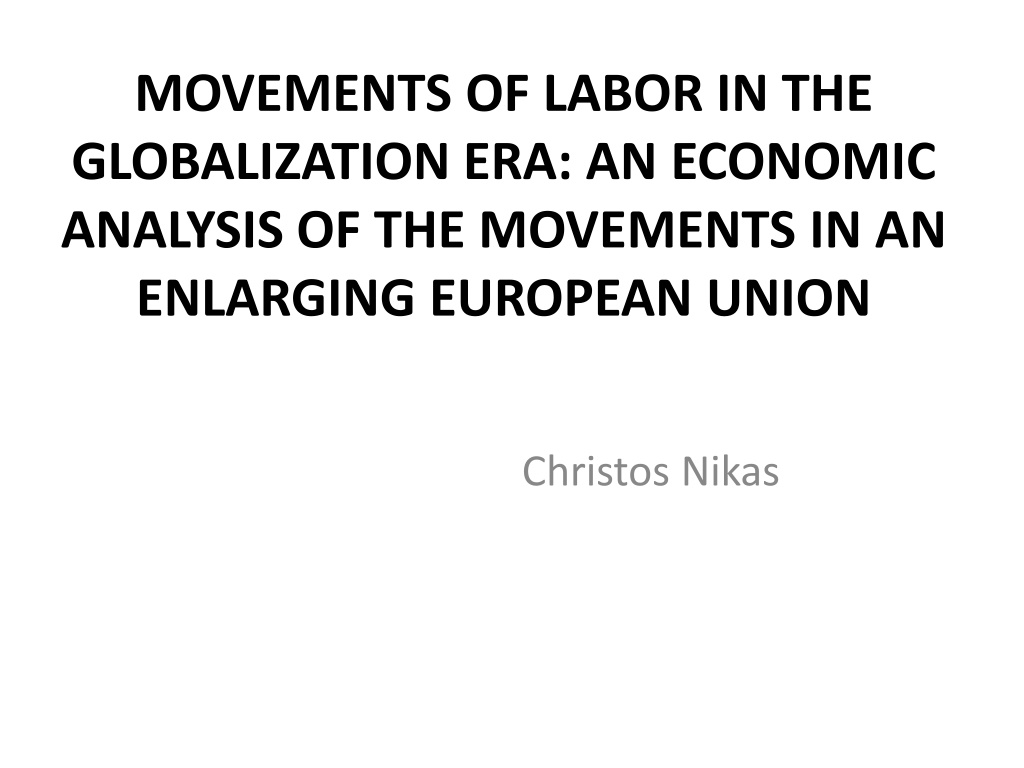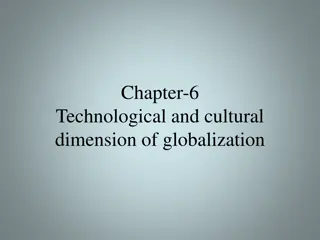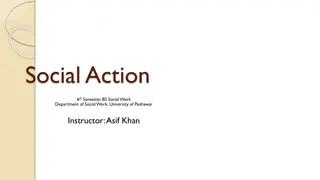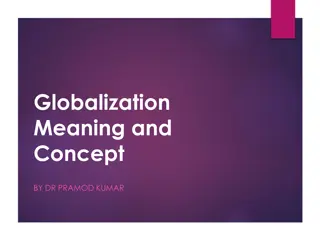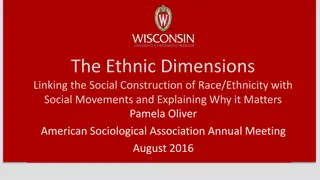Analysis of Labor Movements in the Globalization Era
Contemporary labor movements in the era of globalization differ from previous periods, influenced by factors such as globalization, European integration, the collapse of the socialist system, and economic disparities. The dynamics of migration have evolved, impacting various countries and regions. This economic analysis delves into the changing landscape of labor movements within an expanding European Union. The complexities of free labor mobility, economic transitions, and international pressures are examined in depth.
Download Presentation

Please find below an Image/Link to download the presentation.
The content on the website is provided AS IS for your information and personal use only. It may not be sold, licensed, or shared on other websites without obtaining consent from the author. Download presentation by click this link. If you encounter any issues during the download, it is possible that the publisher has removed the file from their server.
E N D
Presentation Transcript
MOVEMENTS OF LABOR IN THE GLOBALI ATION ERA: AN ECONOMIC ANALYSIS OF THE MOVEMENTS IN AN ENLARGING EUROPEAN UNION Christos Nikas
1. Movements of Labor Contemporary movements of labor differ significantly from those of previous periods. Classic migration schemes (intercontinental permanent emigration to the new countries, temporary emigration from the Mediterranean to the industrially developed countries of Northern Europe) seem to be outdated, since new characteristics seem to apply regarding the typology and the geographic characteristics of the contemporary movements of labor. The new framework consists of four new elements: The on-going process of globalization international economic relations in general and therefore, their basic ingredient, migration. The new directives and characteristics of the contemporary migrations. The fact that the accelerating, in this period, progress of European Integration, is also influencing the movements of labor within the European Union. Introduction: The Framework of the Contemporary which influences
The collapse of the socialist system and the release of unprecedented (in terms of the recent history) push factors for emigration on behalf of the Eastern European countries which are in the process of economic transition. These four factors and how they influence the contemporary movements of labor will be thoroughly analyzed in this lecture.
2. Movements of Labor in the Globalization Era If we define globalization as a process of liberalization of economic transactions on a global scale, than it s content must include by definition the free labor mobility, exactly as it includes the free mobility of goods, services and capital. In fact the worldwide trend, as globalization accelerates, is that migration will concern increasingly more and more countries of the world. It is indicative that in the 1970s, 39 countries of the world could be considered as immigration ones and 29 as emigration ones, in the 1990s, the corresponding numbers were 67 and 55 (a doubling), a development which can be partly attributed to the breaking down of the multi- ethnic states (USSR, Yugoslavia). More important, in the same period, the number of countries, which qualified, both as emigration and immigration ones increased from 4 to 15. The expansion of economic disparities and the fact that globalization is increasing rather than reducing them, intensified the pressures for larger scale migrations from poorer to richer countries.
However, the double talking characterizing the rhetoric of contemporary liberalism and the ability of richer countries to arrange their international economic relations according to their interests led to the following liberalization advocated by globalization cornerstones international trade and movements of capital, it rejects and tries to reduce the international movements of capital. The explanation of this eclectic neo-protectionism and its institutional cover with migration control policies will be discussed at the end of this paper. We should however at this point summarize the basic conclusions on the so far evolution of international movements of labor within the new environment of globalization: contradiction: although includes the its as
The pressures for emigration have been intensified and the movements are massive in some cases, but less massive than in the pre-globalization periods. The recent emigration to USA for example is substantial, but certainly smaller compared to the 1900-1920 period. Emigration from Eastern to Western Europe is smaller than Western countries feared in the early 1990s and certainly smaller than those in the 1960s. We cannot come up with a generally applicable conclusion on whether movements of labor are substitutes or complements to the movements of goods and capital. In some cases a substitution relationship seems to apply, but in others complementarity applies. It is not clear whether movements of labor lead to the convergence of wages and levels of prosperity in the emigration and immigration countries or whether it leads to further divergences.
3. Migration in Europe Until the Late 1980s In the early postwar period migration from Europe continued to display the characteristics of the prewar period with overseas countries dominating as the main recipients of European emigrants. These flows refered to the less developed countries of the European South (Mediterranean) and mainly Greece, Italy Spain and Portugal. Later Jugoslavia and Turkey were added to this group. The European countries of the West-North region, after completing the rebuilding of their economies from the war disasters, experienced the most impressive and uniterupted period of economic growth in their recent history. This growth eventually absorbed their surplus labour and finally led to full employment. The Federal Republic (Western) Germany in particular experienced a fall of the natural rate of unemployment unemployment rate to 0.6%, well below the natural rate of unemployment which, at the time, was believed to be 1%.
This development mainly referred to manufacturing. Indeed the secondary sector soon absorbed all the available reserves of the labor market, unemployed and underemployed as well as labor from agriculture (mainly) and services. This unprecedented growth of the W. European industry would soon come to a bottleneck because of a labor shortage. This was exactly the point of time when the governments of the Northwest European countries turned to the South in order to attract labor. Initially, during the 1950s, Belgium started attracting coalminers. This led to a gradual shift of migration from the overseas to other European countries.
In the early 1960s migration seems to be a clearly intra-European issue. Besides the change of destination there is another element which differentiates this flow from the previous ones, namely it s temporary nature. The desire of the developed European countries to attract temporary immigrants is manifested by the fact that they go as far as establishing a legal framework regarding migration. In fact, they signed bilateral migration agreements with the emigration countries of the South. These agreements provided that the destination countries maintained absolute control of these flows, since they could decide on whom to accept, in which areas and firms the migrants would be employed, the duration of their stay (usually a year with the provision for a second year renewal of the work permit) etc.
It is indicative that the Germans used the term gastarbeiters (guest workers) for the immigrants in their country. However, in spite of the initial intentions of the immigration countries regarding a short-term employment of the foreign workers, they had to redesign their policy on this issue. This could be explained on the basis of the finding that the continuous rotation of the labor force (immigration of workers- repatriation-new inflow of immigrants and so on) was a negative factor for economic growth. New immigrants had a low productivity and needed time in order to get used to the production methods of the receiving countries.
During the 1960s, W. Germany turned out to be the main receiving country absorbing 60% of the migrants from Southern Europe. This can be explained on the basis of the huge labor shortages this country faced because of the fast GDP growth. The inflow of migrants closed this gap fall in the inflow of migrants and eventually solved the problem. It is also indicative that in the late 1960s W. Germany experienced a short but sharp deceleration of growth. This led to an impressive fall in migration. By the time the German economy recovered, migratory flows increased. Regarding the main origin countries (in absolute figures) in the mid-1960s, Greece comes third after Italy and Spain, folloeed by Turkey, Portugal and Jugoslavia. Using migration as a percentage of total population Italy comes first (2.95%)followed by Greece (2.64%), Spain (2.15%), Portugal (1.37%) and Turkey (0.58%). By the early 1970s Portugal has taken the lead followed by Greece.
4. The Characteristics of the Contemporary Movements of Labor We could summarize the main characteristics and directions of the contemporary movements as follows: To a very large extent contemporary movements refer to people who have ethnic, religious or other relationship with the country where they establish themselves in. Jewish emigrants from Russia to Israel, people of German origin from Hungary, Poland etc. to Germany and people of Greek origin from former USSR and Albania to Greece are typical examples. It is not perfectly clear however whether these people emigrated because of the abolition of the obstacles set by the communist regimes in the emigration countries or due to the economic problems these countries faced at the early stages of their transition to the market system. In many cases migration has been illegal, that is without the consensus of the immigration countries and often, it is disguised as political asylum application in order to become legal. Whether a person is indeed a political refugee or simply an illegal immigrant is one of the most difficult to solve problems for the immigration countries.
The propensity to emigrate in relation to the geographic caliber of migration differs by income class of the migrants as follows: Low- income potential emigrants have an extremely high propensity to move to countries near their potential emigrants have an average scale propensity to emigrate to countries of a great distance to their country of origin. Finally low- income skilled potential emigrants have a low propensity of moving to countries far away from their country of origin. Those who mainly move therefore are low-income people to neighboring countries. A form of emigration which is increasingly becoming popular in recent years, refers to the movements of executives from and to the headquarters of multinationals around the world. Although Americans and Europeans were the first to do this, the Japanese are now first in this field. Also, the emigration of professionals like engineers, business consultants, athletes and artists is very common. origin. Middle-income unskilled
The majority of the contemporary movements refers to massive short-term ones and transit migrations where people initially emigrate to country A, their final destination however being country B. In the 1990s countries like Hungary, Poland, Czechia and Slovakia were asked to operate as the frontline of the E.U., when it was found that they are used as transit stations of emigrants from Eastern to Western Europe. A new element of the contemporary movements is that they increasingly refer to females, which now emigrate, not following their husbands as in the past, but independently seeking for employment. Females often prove more effective than males in finding employment in a foreign country mainly due to their decision to accept flexible and low wage jobs (e.g. maids), which are now offered even by middle-class households in the developed countries.
5. The Intra European Union Migrations The operation of the E.U., especially after the completion of the Internal Market in 1993, requires the free mobility of workers from one member- state to another. Organizing massive intra-E.U. migrations was never in the intentions of the Union. The free mobility of workers within the E.U. was considered to be a right of its citizens to seek for employment in any member state, provided that employment is offered, irrespectively of whether people would make use of this right or not. Historically we have the following paradox. Member-states workers exercised this right of free mobility, before these countries joined the E.U. and did not exercise it after their accession. This applies to emigrants from Greece, Spain and Portugal who emigrated massively to the Northern Union countries before the accession of their countries, but did not repeat such movements after the Mediterranean Enlargement of the E.C. in the 1980s. This could be mainly explained on the basis of the differences in employment opportunities between the Northern and the Mediterranean countries in the 1960s, which never re-emerged ever since because of the economic recession and the rise of unemployment in the more developed European countries.
The pull factors for emigration therefore, did not operate from the immigration countries although the push ones from the emigration countries did. Furthermore since the late 1970s we experience the so-called migratory paradox with the three Mediterranean countries becoming destinations of immigrants mainly from third (non - E.U.) countries. The third enlargement of the E.U. referred to developed countries (Austria, Sweden and Finland). Consequently it did not cause substantial intra-E.U. movements. A very crucial question is whether the relatively recent process of enlargement of the E.U. would be followed by a re-appearance of intra-European migration, especially if one takes into account it s relative size (10+3 countries), and the fact that most of potential member-states substantially lag behind the E.U. average in terms of economic development.
Intra-E.U. migration was estimated to be in the area of 600,000 people per year. As an absolute figure it looks substantial, but in relative terms it is practically insignificant for a union operating for more than 60 years. As a percentage of the total population of the EU (15), immigrants from other member-states represent only 1.4%, while immigrants from third countries 3%. To a very large extent therefore, immigration to the E.U. countries continues to refer to non-E.U. rather than union member countries of origin. The characteristics of the recent intra European migratory movements are changing. While in the past (1960s-1990s) it was mainly temporary immigration of unskilled workers, in recent years it is mainly technocrats and highly specialized personnel, which move, most of which on a more permanent basis. Besides the fact that the demand for labor in W. Europe is much less than in the past, this region continues to be considered a de facto potential immigration zone. Also the recent war in Syria has accelerated flows of refugees and asylum seekers to the E.U.
6. Movements of Labor from Eastern to Western Europe The collapse of the socialist system in the early 1990s, was accompanied by phenomena of economic decline for the Eastern European Economies. The most visible symptom of this economic decline was the negative GDP growth rates which, in some cases, led to loss of GDP as high as 40%. This development led to an inevitable rise of unemployment, which combined with the poor perspectives of economic recovery intensified the pressures for massive labor outflows from these countries. Small scale population movements from Eastern Europe sporadically took place in other occasions during the postwar period, but these (almost entirely) referred to political refugees who were returning to their country by the time it s political life was stabilized. The new element in the 1990s was these movements had clearly economic motives. In the early (and most painful) stage of the process of transition of these economies to the market system (1989-1994), 4 million people moved from Eastern to Western Europe. Explaining these movements on a clearly economic basis is quite simple.
The average Eastern European per capita GDP (including the USSR) was 1/7th of the corresponding E.U. one in that period. The corresponding ratio for the poorest country of the first group (Albania) and the richest one of the second group (Luxembourg) was 1 to 30. Almost all the Eastern European countries had a negative migration balance (inflow minus outflow of workers) in the 1990s with Albania loosing 1/3 of its labor force and Bulgaria loosing 1/10 of its population due of emigration. Other countries too however contributed substantially to the intra - European migration of that period such as the countries which emerged from the former USSR, Romania and Poland. On the other hand Germany, Austria, Greece and Italy received the main bulk of these movements. These movements were illegal to a very large extent, in the sense that the procedures of the national legislations or the Shegen Treaty (which regulates the issues of the entry and employment of foreigners in the E.U. member states) were clearly violated. In other cases these movements evolved on the basis of applications for the provision of political asylum.
This trend was fainting out of course as Eastern European countries where progressing towards protection of civil rights. In table I we can see the directions of the movements of labor in that period by country of origin and main destination. Table 1: Movements of Labor of European Interest in the 1990s and 2000s _______________________________________________________________ Country of Origin _______________________________________________________________ Poland Hungary Former Yugoslavia* Croatia and Slovenia Bulgaria Greece Albania Former USSR Countries Other Former USSR Countries, Israel, Greece. _______________________________________________________________ *(except Croatia and Slovenia) democratization and Main Countries of Destination Germany, USA Germany, Canada, USA Italy, Greece Germany Germany, Canada, USA, Greece, Italy
7. Contemporary Movements of Labor: Problems and Content of a Migration Policy The recent movements of labor and refugees evolved in an environment of skepticism of the destination countries regarding their implications on the employment of their labor force and a series of social problems such as the acceleration of crime, the marginalization of immigrants, the problems of their social assimilation etc. Many of these reservations had no serious basis (e.g. immigrants deprive jobs from the native labor force, since immigrants usually undertake the jobs nobody wishes to accept). Some others, like the difficulties of social assimilation are more justified, but they are mainly due to the fact that immigration countries were not prepared to absorb inflows of that size, in terms of the designing and implementation of the appropriate policies, Greece being a typical example. The argument of accelerating crime rates due to the immigrants, although not entirely without basis, is exaggerated, based on wrong or simply casual interpretations of the statistics.
Illegal (or undocumented) Migration mainly refers to: -Those who cross the boarders illegally -Those have entered legally but remain for a period exceeding their visa or work permit. -The family members of those legally residing to a country without a will to extent this right to their family members. -Those requesting political asylum without being refugees in reality.
Unfortunately a just assessment of the phenomenon under conditions of increasing unemployment and social insecurity proved to be very difficult. Consequently problems such as xenophobia emerged. Xenophobia was the main reason (or simply alibi) for the formation of skeptic (in the best case) or clearly hostile attitudes of many W. European countries (and the E.U. in total) towards the immigrants. A careful assessment of the issue of unwanted immigration however, needs to seriously take into account the following: The application of controls and restrictions in the entry and employment of foreigners proved to be ineffective in most cases. The only effects these policies brought, was the further marginalization and deterioration conditions for the immigrants. of wages and working
Employers usually prefer illegal immigrants in order to be able to pay them less and avoid social security costs. In the Netherlands the main reasons for the preference in employing illegal immigrants were found to be low cost, production peaks and the fact that they are willing to undertake heavy and unhealthy jobs, the so called 3Ds. European trade unions now seem to favor more liberal approaches regarding immigration on the ground that this is best for the native workers interests. This follows the conclusion that the legitimate employment of immigrants brings hidden economy to the surface, reduces the pressures on wages, increases union membership and brings additional income to the social security system. The basic tasks regarding the contemporary migratory flows from the immigration countries point of view are: The controlling of legitimate immigration and the social assimilation of those established for a long period or permanently.
The policies on stopping illegal immigration. Permanent solutions on reducing the pressure for further immigrations through the improvement of international relations. The impact of including different ethnic groups in the labor force and the population the society, the culture and the concept of the nation state.
8. Conclusions The Perspectives of Migration in the E.U. The so far experience with the recent movements of labor verifies most of Ravenstein s laws on migration. These laws are a classic part of economic thought on migration and have a great explanatory value even today, 130 years after their first presentation. We could use these laws in order to discuss the perspectives of migration in general as follows: Differences in the income levels, the employment opportunities and other key economic variables between the countries, are increasing the migration propensity. On the regional dimension of migration people mainly move from rural areas to the urban centers.
It is doubtful whether migration facilitates economic convergence between the emigration and immigration countries. Although remittances could be seen as a compensation mechanism, there are reservations on whether the mechanism is fully compensatory as the neoclassical economic thought would imply. The evidence seems to verify the application of the unequal exchange and cumulative causality mechanisms rather than the economic convergence ones. Economic and general coincidence will certainly continue to influence international movements of labor as to their size and direction.
However, for the particular case of the movements within the enlarged E.U. some further points need to be taken into account: Full membership will eventually (after the end of the transition periods) provide citizens of the new members the right to seek employment in other E.U. states. The right to emigrate as we have seen however is not enough to cause such movements if the pull factors (mainly availability of jobs) are not in operation in the destination countries. The present situation in the W. European labor markets does not seem promising regarding the employment of foreign labor. The rapid economic growth in most former transition economies and now new or potential E.U. members, although not enough to bring fast economic convergence to the union average, will reduce the pressures for emigration.
The accession to the E.U. will help the new members to solve the administrative problems (bureaucracy, corruption etc) which have discouraged foreign investments. The inflow of foreign capital, together with the expected inflow of E.U. funds will bring the job to the worker instead of the the worker to the job emigration implies. Also the expected acceleration of intra-industry trade with other member-states may discourage the outflow of workers. As a conclusion massive intra-E.U. migration should not be expected, at least not from the new members. Small movements of qualified people temporary and more permanent are more likely. This conclusion is based to a combination of arguments. Firstly, the pull factors from the immigration countries do not operate at present and are not expected to do so in the near future. Second the push ones will be disamplified following the progress of transition and economic recovery and the membership to the E.U.
